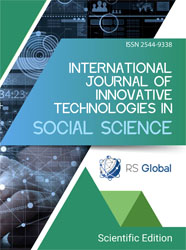EARLY AND LATE COMPLICATIONS FOLLOWING VISION CORRECTION WITH SMILE AND LASIK METHODS. ANALYSIS OF DIFFERENCES
Abstract
Vision correction through refractive surgical procedures has become increasingly precise and patient-specific, with SMILE (Small Incision Lenticule Extraction) and LASIK (Laser-Assisted in Situ Keratomileusis) emerging as two of the most commonly performed techniques for the treatment of myopia and astigmatism. Both methods offer excellent visual outcomes and rapid postoperative recovery; however, they differ significantly in terms of surgical approach, which in turn influences the profile and frequency of complications. This review explores and compares the complications associated with each procedure, highlighting key differences in both early and late postoperative outcomes.
Early complications such as dry eye syndrome, transient visual disturbances, and epithelial healing irregularities tend to occur more frequently after LASIK. This is likely due to the creation of a corneal flap in LASIK, which can disrupt more corneal nerves and tissues. In contrast, SMILE, which involves only a small peripheral incision without a flap, preserves more of the corneal architecture, leading to a reduced incidence of postoperative dryness and inflammation.
Furthermore, long-term complications, including corneal ectasia, appear to be less prevalent following SMILE, likely owing to the better biomechanical stability maintained in the cornea. A nuanced understanding of these complication patterns is essential for clinicians to select the most appropriate technique based on individual patient characteristics, ocular anatomy, and lifestyle demands. Tailoring the surgical approach not only improves clinical outcomes but also helps in minimizing procedural risks and enhancing patient satisfaction.
References
Aristeidou A, Taniguchi EV, Tsatsos M, et al. The evolution of corneal and refractive surgery with the femtosecond laser. Eye Vis. 2015;2:12. doi:10.1186/s40662-015-0022-6.
Miraftab M, Hashemi H, Aghamirsalim M, et al. Matched comparison of corneal higher order aberrations induced by SMILE to femtosecond assisted LASIK and to PRK in correcting moderate and high myopia: 3.00mm vs. 6.00mm. BMC Ophthalmol. 2021;21:216. doi:10.1186/s12886-021-01987-3.
Roszkowska AM, Urso M, Signorino A, Aragona P. Use of the Femtosecond Lasers in Ophthalmology. EPJ Web Conf. 2018;167:05004. doi:10.1051/epjconf/201816705004.
Janiszewska-Bil D, Grabarek BO, Lyssek-Boron A, et al. Comparative Analysis of Corneal Wound Healing: Differential Molecular Responses in Tears Following PRK, FS-LASIK, and SMILE Procedures. Biomedicines. 2024;12(2289). doi:10.3390/biomedicines12102289.
Jin Y, Wang Y, Xu L, et al. Comparison of the Optical Quality between Small Incision Lenticule Extraction and Femtosecond Laser LASIK. J Ophthalmol. 2016;2016:2507973. doi:10.1155/2016/2507973.
Budiyasa S, Putri I. Refractive Error Correction in Bali, Indonesia: A Retrospective Cohort Study of ReLEx SMILE and Femto-LASIK Outcomes. Sriwijaya J Ophthalmol. 2023;7(2):e122. doi:10.37275/sjo.v7i2.122.
Swetha T. Comparison of SMILE and FS-Lasik procedures in terms of dry eye disease. Eur J Cardiovasc Med. 2019;9(4):60-61.
Han T, Xu Y, Han X, et al. Quality of life impact of refractive correction (QIRC) results three years after SMILE and FS-LASIK. Health Qual Life Outcomes. 2020;18:107. doi:10.1186/s12955-020-01362-8.
Gurnani B, Kaur K. Recent Advances in Refractive Surgery: An Overview. Clin Ophthalmol. 2024;18:2467-2472. doi:10.2147/OPTH.S481421.
Solomon KD, Donnenfeld ED, Sandoval HP, et al. Clinical outcomes of small incision lenticule extraction (SMILE) compared with laser in situ keratomileusis (LASIK) for myopia: A meta-analysis. Ophthalmology. 2020;127(7):886-897. doi:10.1016/j.ophtha.2020.01.008.
Reinstein DZ, Archer TJ, Gobbe M. Small Incision Lenticule Extraction (SMILE) history, fundamentals of a new refractive surgery technique and clinical outcomes. Eye Vis. 2014;1:3. doi:10.1186/s40662-014-0003-7.
Damgaard IB, Ivarsen A, Hjortdal J. Long-term clinical outcomes and patient satisfaction after small-incision lenticule extraction (SMILE) and laser in situ keratomileusis (LASIK) for myopia. Acta Ophthalmol. 2021;99(1):e65-e74. doi:10.1111/aos.14433.
Alió JL, Soria FA, Abbouda A, Peña-García P. Laser refractive surgery for myopia: A review of the literature and the role of small-incision lenticule extraction. J Refract Surg. 2018;34(8):558-570. doi:10.3928/1081597X-20180717-02.
Sekundo W, Kunert KS, Blum M. Small Incision Lenticule Extraction (ReLEx SMILE) for myopia and astigmatism: Safety, efficacy and quality of vision after 12 months. Graefes Arch Clin Exp Ophthalmol. 2011;249(9):1647-1659. doi:10.1007/s00417-011-1720-4.
Zhou X, Zhou Y, Zhang J, et al. Short-term and long-term clinical outcomes of small incision lenticule extraction (SMILE) and comparison with femtosecond LASIK. J Cataract Refract Surg. 2014;40(6):954-962. doi:10.1016/j.jcrs.2014.06.014.
Blum M, Täubig K, Gruhn C, Sekundo W, Kunert KS. Femtosecond lenticule extraction (ReLEx) for correction of myopia: Preliminary results. Klin Monbl Augenheilkd. 2010;227(1):1-7. doi:10.1055/s-0029-1245335.
Ivarsen A, Asp S, Hjortdal J. Small-incision lenticule extraction (SMILE) for moderate to high myopia: Predictability, safety, and patient satisfaction. J Cataract Refract Surg. 2014;40(11):1830-1838. doi:10.1016/j.jcrs.2014.03.030.
Ganesh S, Brar S, Pawar A. Clinical outcomes of small incision lenticule extraction (SMILE) and comparison with femtosecond LASIK for myopia. J Cataract Refract Surg. 2014;40(11):1836-1843. doi:10.1016/j.jcrs.2014.03.026.
Views:
36
Downloads:
13
Copyright (c) 2025 Sara Langner, Ewa Katarzyna Malaka, Martyna Byrska, Marlena Zubiak, Hanna Barska-Kobylińska, Marta Janura, Eliza Kawalska, Maciej Borowski, Jakub Motor, Alicja Grzelak

This work is licensed under a Creative Commons Attribution 4.0 International License.
All articles are published in open-access and licensed under a Creative Commons Attribution 4.0 International License (CC BY 4.0). Hence, authors retain copyright to the content of the articles.
CC BY 4.0 License allows content to be copied, adapted, displayed, distributed, re-published or otherwise re-used for any purpose including for adaptation and commercial use provided the content is attributed.















